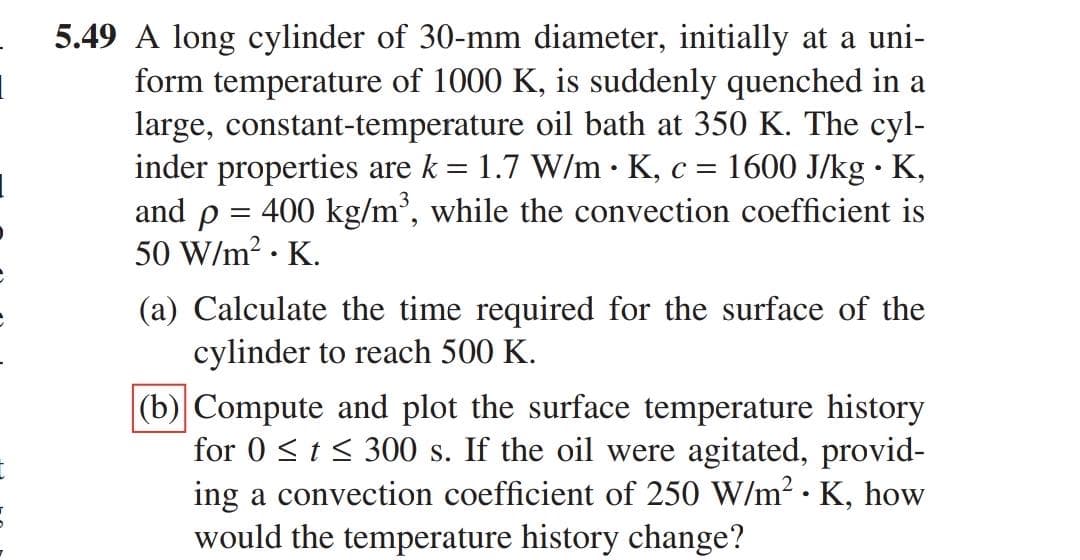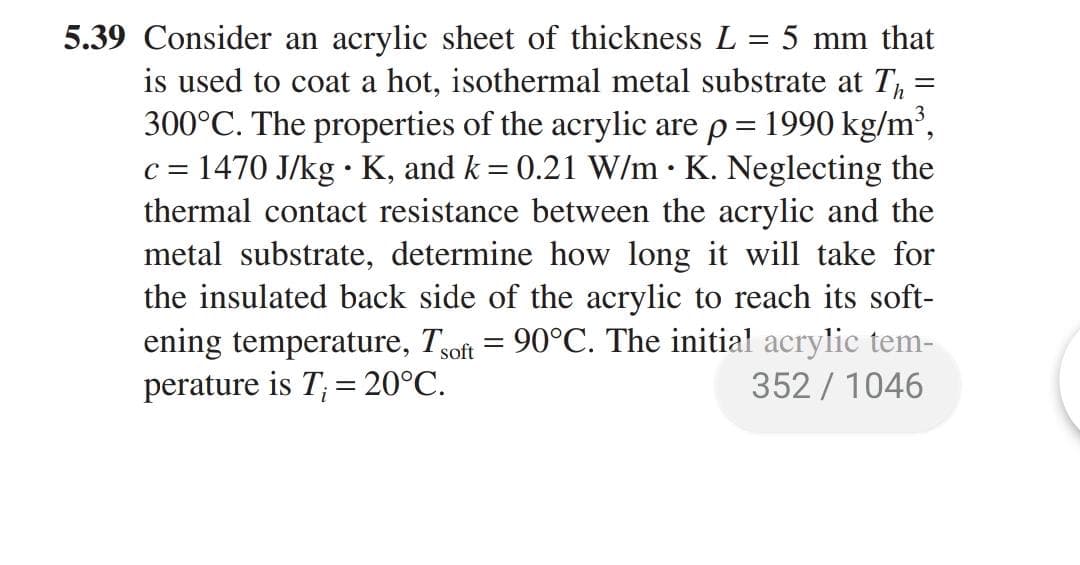5.39 Consider an acrylic sheet of thickness L = 5 mm that is used to coat a hot, isothermal metal substrate at T, = 300°C. The properties of the acrylic are p= 1990 kg/m², c = 1470 J/kg · K, and k = 0.21 W/m • K. Neglecting the thermal contact resistance between the acrylic and the metal substrate, determine how long it will take for the insulated back side of the acrylic to reach its soft- ening temperature, Tyoft = 90°C. The initial acrylic tem- perature is T; = 20°C. %3D 352/ 1046
5.39 Consider an acrylic sheet of thickness L = 5 mm that is used to coat a hot, isothermal metal substrate at T, = 300°C. The properties of the acrylic are p= 1990 kg/m², c = 1470 J/kg · K, and k = 0.21 W/m • K. Neglecting the thermal contact resistance between the acrylic and the metal substrate, determine how long it will take for the insulated back side of the acrylic to reach its soft- ening temperature, Tyoft = 90°C. The initial acrylic tem- perature is T; = 20°C. %3D 352/ 1046
Principles of Heat Transfer (Activate Learning with these NEW titles from Engineering!)
8th Edition
ISBN:9781305387102
Author:Kreith, Frank; Manglik, Raj M.
Publisher:Kreith, Frank; Manglik, Raj M.
Chapter2: Steady Heat Conduction
Section: Chapter Questions
Problem 2.30P: 2.30 An electrical heater capable of generating 10,000 W is to be designed. The heating element is...
Related questions
Question
What is the solution for this question

Transcribed Image Text:5.49 A long cylinder of 30-mm diameter, initially at a uni-
form temperature of 1000 K, is suddenly quenched in a
large, constant-temperature oil bath at 350 K. The cyl-
inder properties are k = 1.7 W/m · K, c = 1600 J/kg · K,
and p = 400 kg/m', while the convection coefficient is
50 W/m? · K.
(a) Calculate the time required for the surface of the
cylinder to reach 500 K.
(b) Compute and plot the surface temperature history
for 0 <t< 300 s. If the oil were agitated, provid-
ing a convection coefficient of 250 W/m2 · K, how
would the temperature history change?

Transcribed Image Text:5.39 Consider an acrylic sheet of thickness L = 5 mm that
is used to coat a hot, isothermal metal substrate at T,:
300°C. The properties of the acrylic are p= 1990 kg/m',
c = 1470 J/kg •K, and k = 0.21 W/m · K. Neglecting the
thermal contact resistance between the acrylic and the
metal substrate, determine how long it will take for
the insulated back side of the acrylic to reach its soft-
ening temperature, Tsoft = 90°C. The initial acrylic tem-
perature is T; = 20°C.
%3D
352 / 1046
Expert Solution
This question has been solved!
Explore an expertly crafted, step-by-step solution for a thorough understanding of key concepts.
This is a popular solution!
Trending now
This is a popular solution!
Step by step
Solved in 5 steps with 5 images

Knowledge Booster
Learn more about
Need a deep-dive on the concept behind this application? Look no further. Learn more about this topic, mechanical-engineering and related others by exploring similar questions and additional content below.Recommended textbooks for you

Principles of Heat Transfer (Activate Learning wi…
Mechanical Engineering
ISBN:
9781305387102
Author:
Kreith, Frank; Manglik, Raj M.
Publisher:
Cengage Learning

Principles of Heat Transfer (Activate Learning wi…
Mechanical Engineering
ISBN:
9781305387102
Author:
Kreith, Frank; Manglik, Raj M.
Publisher:
Cengage Learning